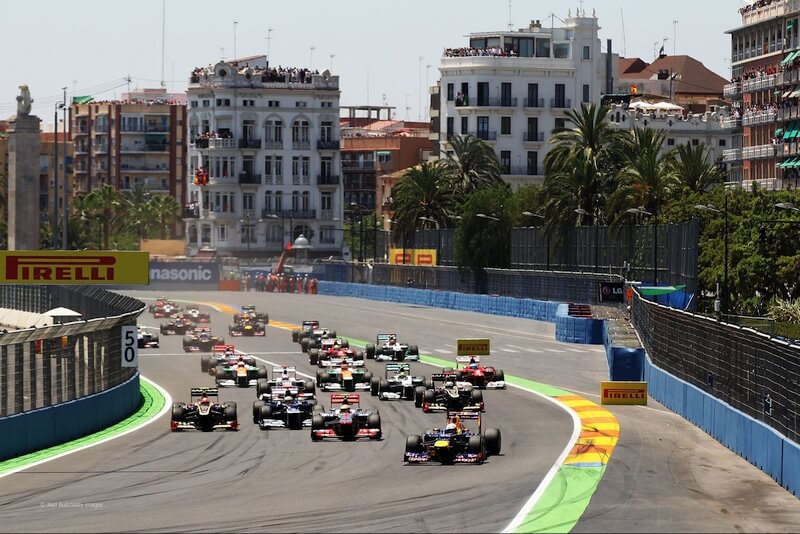
Formula 1 in the streets of Valencia
There’s no need to worry about moving around Valencia. There is a lot of traffic but it flows smoothly. The roads and bike paths of the city are kept in good condition, and the public transportation – such as the underground and the buses – are affordable. Thanks to the optimal size, weather, flat landscape, and infrastructure of Valencia, the best ways to move around the city are on foot and by bike.
Valencia Underground
The underground – known in Spain as the Metro – connects to much of the city, except for the southern parts of the city (home of the famous City of Arts of Science). The Valencian underground network might not be on the scale as some other metropolitan underground networks, but it still offers the fastest, most convenient, and very reliable ways to move through the city.
Don’t be surprised if your underground ride goes above ground – the underground and the trams in Valencia all run on the same network. The fare you pay depends on how far you will be travelling, with the city split into four zones. Zone A is the city centre, while B, C, and D are further out, as much as 30KM away from the centre of the city. If you plan on being a regular visitor then you’re best off getting a 10 journey travel card – called bono in Spain. The underground also presents the fastest, cheapest, and very convenient way to reach the airport, which is just 30 minutes away from the city centre.
The only problem with taking the underground is the timetable. Trains run until around 11PM (with the occasional exception for holidays and festivals), which isn’t in tune with the nature of Valencia given that most people are still out enjoying themselves and having dinner at that time.
Buses
The bus offers another great way to get around Valencia, but it can be challenging to understand the routes because they aren’t user friendly. Buses are also a bit less reliable than taking the underground. Buses are regularly rerouted due to demonstrations, races, and processions, and sometimes you’re left not even knowing what the new stops are. Some buses do operate at night, but you should always look through the timetable ahead of schedule because they only run every few hours.
Buses can be more expensive than the underground zone A and it’s best to check which journey card you need through the official website. If you want to use both the bus and underground, there is the option to have a card that works with both.
A good option for short trips around and out of the city is the Metrobus. These are yellow buses that connect the city with the nearby villages with comparatively cheap fares.
Taxis, etc.
Taxis can be an affordable method of travel, especially when it becomes difficult to use public transport after 11PM. Night fares in the city run between 9PM and 7AM, with a minimum charge of €6. This means you would be charged €6 euros even with a small journey. It can cost up to around €30 to catch a taxi from the city to the airport.
Driving in Valencia
Valencia is the kind of city you should have no problem living in without a car, but there are some things you should prepare for if you do want a car:
In terms of parking in Valencia, you should be able to find free parking out on the streets. There are blue and orange lines marking paid parking zones in busy areas such as the city centre. Parking here can cost around €1 per hour (€2 in the old town), but you can’t pay for more than 2 hours in advance – making this a good choice for a short visit. Parking charges apply between 9AM and 2PM and 4PM to 8PM Monday to Saturday. Parking is free in these zones out of hours. There are also a range of public car parks dotted across the city.
As far as parking goes, it’s acceptable to bump other cars as you park and leave as little distance between cars as possible. You have to accept the fact someone is going to scratch your car in Valencia. Something else to consider is that “double parking” is a common practice. There are lots of cars parked in two rows along the road. If you are blocked by a car in the outer lane then you are expected to push it out of the way. This is one case where we’d have to recommend not copying the locals. The parking and towing fines can be over €300. Don’t forget to look at the parking signs and check for yellow lines. If there isn’t a yellow line then – even if there’s lots of other cars parked there – it’s not legal so don’t do it.
The traffic of Valencia can move quickly, but things have been slowing down lately due to the increase in the number of speed cameras. Even so, average road speeds can reach up to 70KPH on roads where the legal limit is 50KPH. Unfortunately, there is an epidemic of drink driving in the city as well due to the lack of controls of alcohol.
When deciding which transportation method is right for you, you should remember that Valencia is great for riding scooters in as they are fast, cheap, and can be parked anywhere you want.
Biking and Walking in Valencia
The weather in Valencia is typically warm and sunny all through the year, so consider enjoying a nice stroll. Walking is healthy and convenient, and the streets of Valencia are generally safe, even late at night.
There is also the option of riding a bicycle. The city has lots of bicycle paths running through it. The climate of the city, along with the size and flat landscape, mean that Valencia is ideal for biking. One thing to keep in mind is that you shouldn’t leave your bike out on the street, and that it’s better to purchase a good lock for your bike than come back to find it’s been stolen.
There is even a bike scheme available in Valencia called ValenBisi. There is an annual subscription fee but it’s under €30. There is one disadvantage however, and that is that the public bikes can be heavy and difficult to park, due to the limited spaces available at bike stations, and there is also the matter of availability.




No responses yet